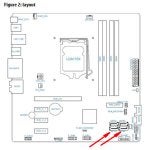Tech Support Guy System Info Utility version 1.0.0.4
OS Version: Microsoft Windows 10 Home, 64 bit
Processor: Intel(R) Core(TM) i7-3770 CPU @ 3.40GHz, Intel64 Family 6 Model 58 Stepping 9
Processor Count: 8
RAM: 10197 Mb
Graphics Card: AMD Radeon HD 7570, 1024 Mb
Hard Drives: C: 911 GB (832 GB Free); D: 19 GB (2 GB Free);
Motherboard: PEGATRON CORPORATION, 2AD5
Antivirus: Windows Defender, Disabled
I will be removing my HDD drive and replacing it with a SSD. I know for sure I have two USB 3.0 ports supported so I can plug in 3.0 flash drives in the front of my pc case, but this is a bit of different than this question.
Once I physically install the SSD drive inside my desktop pc, I know I need to plug in a SATA power cable and a SATA data cable.
My question is this: how can I tell (visually) which SATA Data header is a 3.0 header and not a 2.0 header?
Hope I have explained this okay.
OS Version: Microsoft Windows 10 Home, 64 bit
Processor: Intel(R) Core(TM) i7-3770 CPU @ 3.40GHz, Intel64 Family 6 Model 58 Stepping 9
Processor Count: 8
RAM: 10197 Mb
Graphics Card: AMD Radeon HD 7570, 1024 Mb
Hard Drives: C: 911 GB (832 GB Free); D: 19 GB (2 GB Free);
Motherboard: PEGATRON CORPORATION, 2AD5
Antivirus: Windows Defender, Disabled
I will be removing my HDD drive and replacing it with a SSD. I know for sure I have two USB 3.0 ports supported so I can plug in 3.0 flash drives in the front of my pc case, but this is a bit of different than this question.
Once I physically install the SSD drive inside my desktop pc, I know I need to plug in a SATA power cable and a SATA data cable.
My question is this: how can I tell (visually) which SATA Data header is a 3.0 header and not a 2.0 header?
Hope I have explained this okay.





